Ethics and Governance: The Impact of Formal Ethics Training
VerifiedAdded on 2020/03/04
|10
|2881
|142
Essay
AI Summary
This essay examines the role and impact of formal ethics training programs within organizations, particularly in light of the United States Sentencing Guidelines. It outlines arguments supporting the promotion of such training, highlighting its potential to foster ethical organizational cultures by influencing values, beliefs, and behaviors. The essay discusses various components of formal ethics programs, including codes of ethics and the importance of leadership in setting ethical standards. It also addresses criticisms, such as concerns about the superficiality of training and potential conflicts of interest, while emphasizing the significance of a multi-system framework that integrates both formal and informal ethical practices. The analysis underscores the benefits of comprehensive ethics training in promoting a positive work environment, encouraging ethical decision-making, and ultimately contributing to the achievement of organizational goals. The essay concludes that formal ethical training is not merely cosmetic but a crucial element in shaping an ethical workplace.
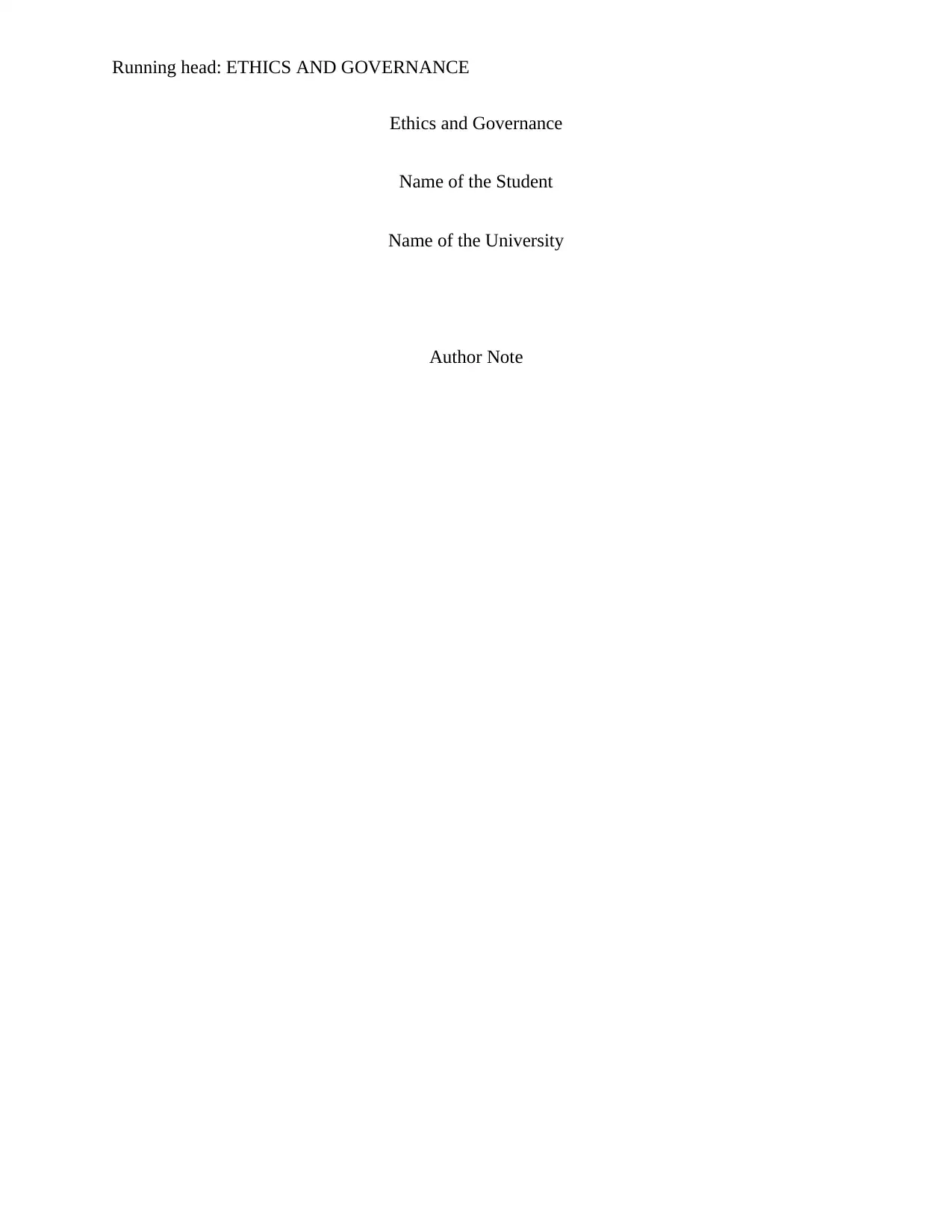
Running head: ETHICS AND GOVERNANCE
Ethics and Governance
Name of the Student
Name of the University
Author Note
Ethics and Governance
Name of the Student
Name of the University
Author Note
Paraphrase This Document
Need a fresh take? Get an instant paraphrase of this document with our AI Paraphraser
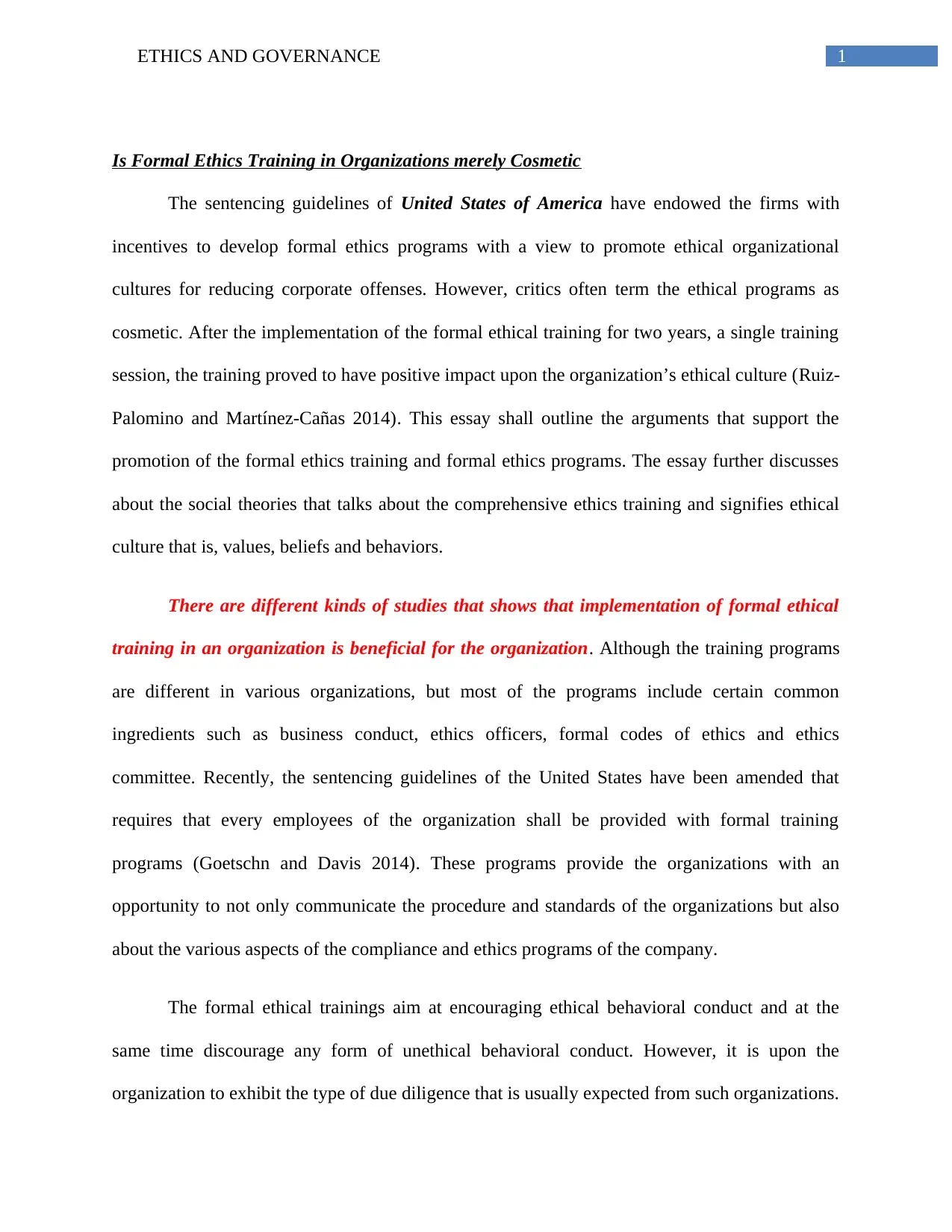
1ETHICS AND GOVERNANCE
Is Formal Ethics Training in Organizations merely Cosmetic
The sentencing guidelines of United States of America have endowed the firms with
incentives to develop formal ethics programs with a view to promote ethical organizational
cultures for reducing corporate offenses. However, critics often term the ethical programs as
cosmetic. After the implementation of the formal ethical training for two years, a single training
session, the training proved to have positive impact upon the organization’s ethical culture (Ruiz-
Palomino and Martínez-Cañas 2014). This essay shall outline the arguments that support the
promotion of the formal ethics training and formal ethics programs. The essay further discusses
about the social theories that talks about the comprehensive ethics training and signifies ethical
culture that is, values, beliefs and behaviors.
There are different kinds of studies that shows that implementation of formal ethical
training in an organization is beneficial for the organization. Although the training programs
are different in various organizations, but most of the programs include certain common
ingredients such as business conduct, ethics officers, formal codes of ethics and ethics
committee. Recently, the sentencing guidelines of the United States have been amended that
requires that every employees of the organization shall be provided with formal training
programs (Goetschn and Davis 2014). These programs provide the organizations with an
opportunity to not only communicate the procedure and standards of the organizations but also
about the various aspects of the compliance and ethics programs of the company.
The formal ethical trainings aim at encouraging ethical behavioral conduct and at the
same time discourage any form of unethical behavioral conduct. However, it is upon the
organization to exhibit the type of due diligence that is usually expected from such organizations.
Is Formal Ethics Training in Organizations merely Cosmetic
The sentencing guidelines of United States of America have endowed the firms with
incentives to develop formal ethics programs with a view to promote ethical organizational
cultures for reducing corporate offenses. However, critics often term the ethical programs as
cosmetic. After the implementation of the formal ethical training for two years, a single training
session, the training proved to have positive impact upon the organization’s ethical culture (Ruiz-
Palomino and Martínez-Cañas 2014). This essay shall outline the arguments that support the
promotion of the formal ethics training and formal ethics programs. The essay further discusses
about the social theories that talks about the comprehensive ethics training and signifies ethical
culture that is, values, beliefs and behaviors.
There are different kinds of studies that shows that implementation of formal ethical
training in an organization is beneficial for the organization. Although the training programs
are different in various organizations, but most of the programs include certain common
ingredients such as business conduct, ethics officers, formal codes of ethics and ethics
committee. Recently, the sentencing guidelines of the United States have been amended that
requires that every employees of the organization shall be provided with formal training
programs (Goetschn and Davis 2014). These programs provide the organizations with an
opportunity to not only communicate the procedure and standards of the organizations but also
about the various aspects of the compliance and ethics programs of the company.
The formal ethical trainings aim at encouraging ethical behavioral conduct and at the
same time discourage any form of unethical behavioral conduct. However, it is upon the
organization to exhibit the type of due diligence that is usually expected from such organizations.
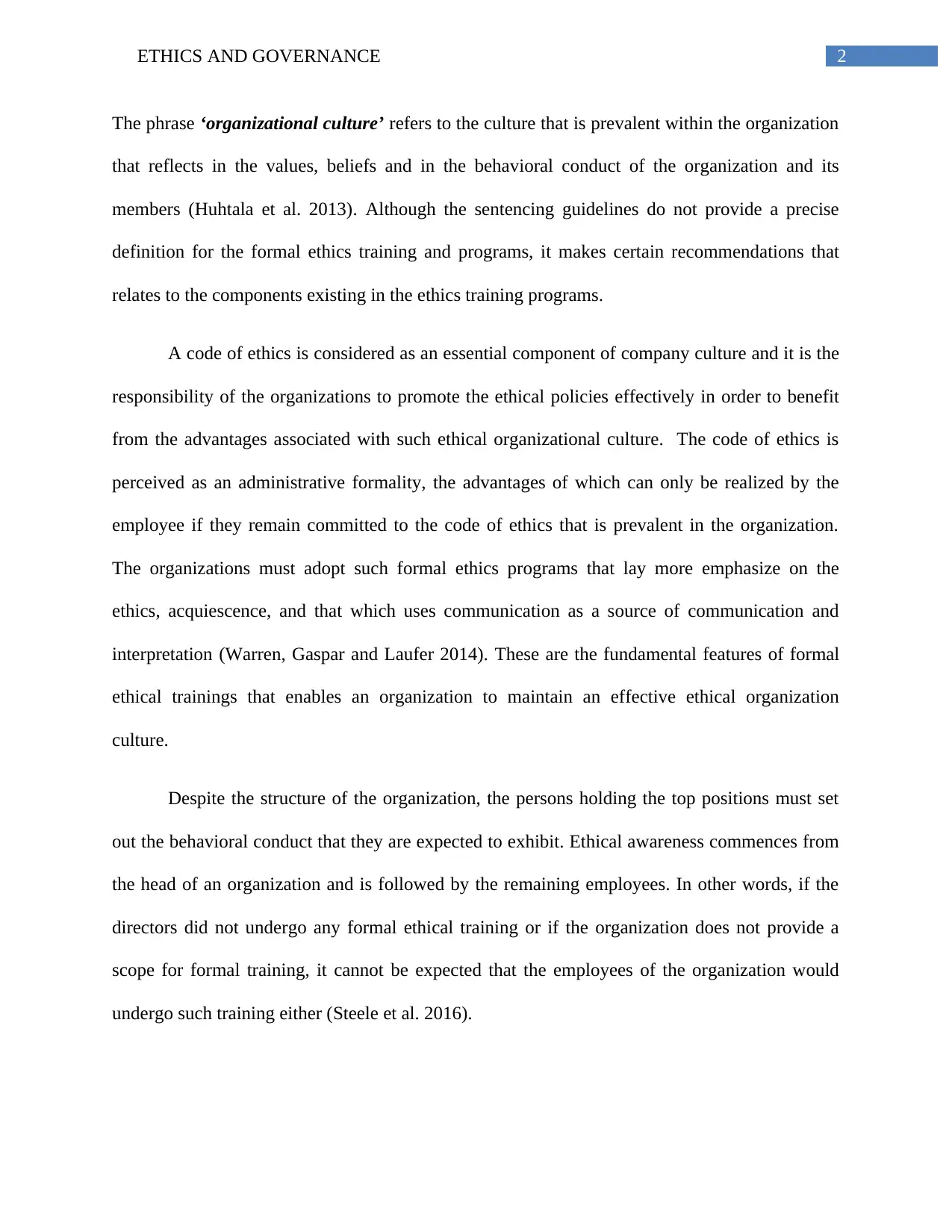
2ETHICS AND GOVERNANCE
The phrase ‘organizational culture’ refers to the culture that is prevalent within the organization
that reflects in the values, beliefs and in the behavioral conduct of the organization and its
members (Huhtala et al. 2013). Although the sentencing guidelines do not provide a precise
definition for the formal ethics training and programs, it makes certain recommendations that
relates to the components existing in the ethics training programs.
A code of ethics is considered as an essential component of company culture and it is the
responsibility of the organizations to promote the ethical policies effectively in order to benefit
from the advantages associated with such ethical organizational culture. The code of ethics is
perceived as an administrative formality, the advantages of which can only be realized by the
employee if they remain committed to the code of ethics that is prevalent in the organization.
The organizations must adopt such formal ethics programs that lay more emphasize on the
ethics, acquiescence, and that which uses communication as a source of communication and
interpretation (Warren, Gaspar and Laufer 2014). These are the fundamental features of formal
ethical trainings that enables an organization to maintain an effective ethical organization
culture.
Despite the structure of the organization, the persons holding the top positions must set
out the behavioral conduct that they are expected to exhibit. Ethical awareness commences from
the head of an organization and is followed by the remaining employees. In other words, if the
directors did not undergo any formal ethical training or if the organization does not provide a
scope for formal training, it cannot be expected that the employees of the organization would
undergo such training either (Steele et al. 2016).
The phrase ‘organizational culture’ refers to the culture that is prevalent within the organization
that reflects in the values, beliefs and in the behavioral conduct of the organization and its
members (Huhtala et al. 2013). Although the sentencing guidelines do not provide a precise
definition for the formal ethics training and programs, it makes certain recommendations that
relates to the components existing in the ethics training programs.
A code of ethics is considered as an essential component of company culture and it is the
responsibility of the organizations to promote the ethical policies effectively in order to benefit
from the advantages associated with such ethical organizational culture. The code of ethics is
perceived as an administrative formality, the advantages of which can only be realized by the
employee if they remain committed to the code of ethics that is prevalent in the organization.
The organizations must adopt such formal ethics programs that lay more emphasize on the
ethics, acquiescence, and that which uses communication as a source of communication and
interpretation (Warren, Gaspar and Laufer 2014). These are the fundamental features of formal
ethical trainings that enables an organization to maintain an effective ethical organization
culture.
Despite the structure of the organization, the persons holding the top positions must set
out the behavioral conduct that they are expected to exhibit. Ethical awareness commences from
the head of an organization and is followed by the remaining employees. In other words, if the
directors did not undergo any formal ethical training or if the organization does not provide a
scope for formal training, it cannot be expected that the employees of the organization would
undergo such training either (Steele et al. 2016).
⊘ This is a preview!⊘
Do you want full access?
Subscribe today to unlock all pages.

Trusted by 1+ million students worldwide
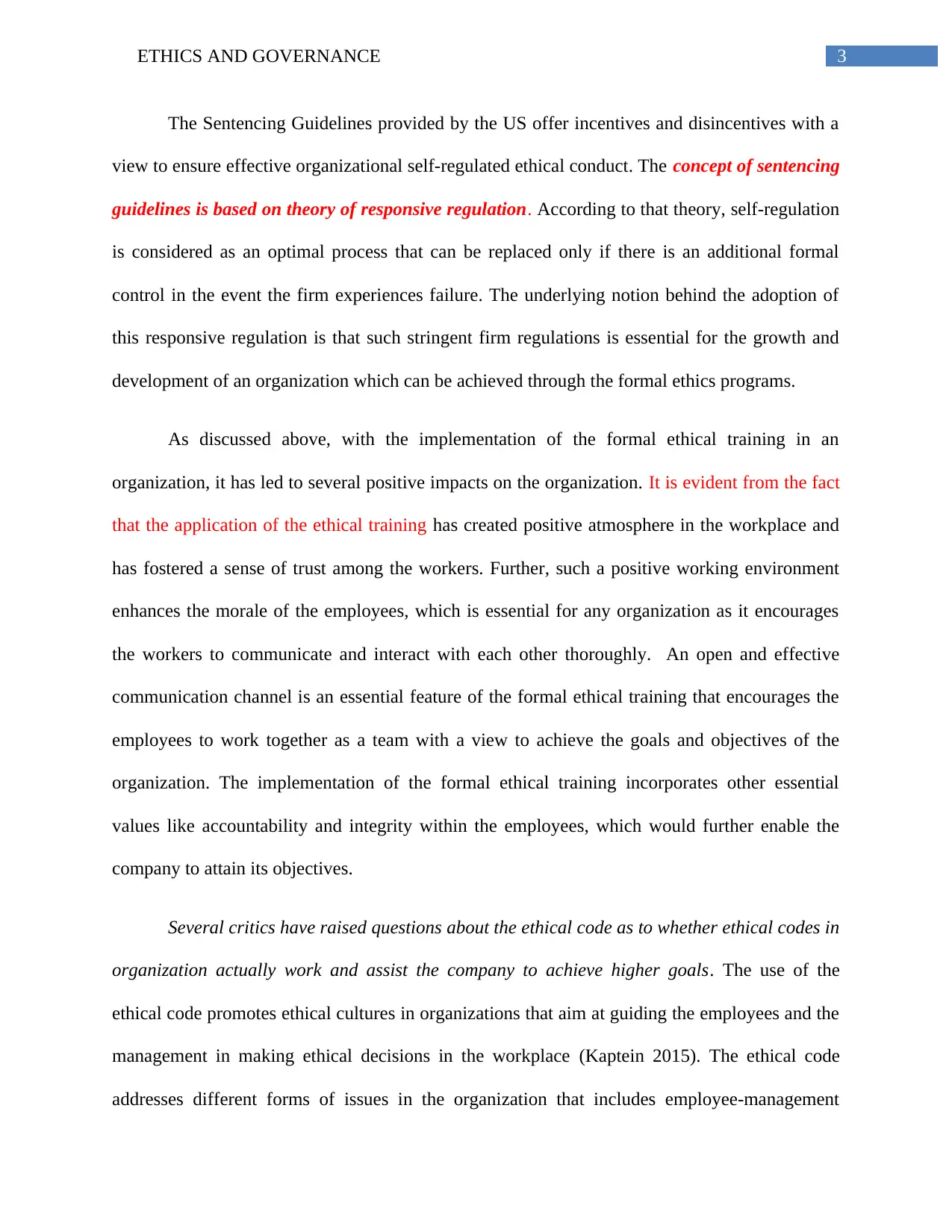
3ETHICS AND GOVERNANCE
The Sentencing Guidelines provided by the US offer incentives and disincentives with a
view to ensure effective organizational self-regulated ethical conduct. The concept of sentencing
guidelines is based on theory of responsive regulation. According to that theory, self-regulation
is considered as an optimal process that can be replaced only if there is an additional formal
control in the event the firm experiences failure. The underlying notion behind the adoption of
this responsive regulation is that such stringent firm regulations is essential for the growth and
development of an organization which can be achieved through the formal ethics programs.
As discussed above, with the implementation of the formal ethical training in an
organization, it has led to several positive impacts on the organization. It is evident from the fact
that the application of the ethical training has created positive atmosphere in the workplace and
has fostered a sense of trust among the workers. Further, such a positive working environment
enhances the morale of the employees, which is essential for any organization as it encourages
the workers to communicate and interact with each other thoroughly. An open and effective
communication channel is an essential feature of the formal ethical training that encourages the
employees to work together as a team with a view to achieve the goals and objectives of the
organization. The implementation of the formal ethical training incorporates other essential
values like accountability and integrity within the employees, which would further enable the
company to attain its objectives.
Several critics have raised questions about the ethical code as to whether ethical codes in
organization actually work and assist the company to achieve higher goals. The use of the
ethical code promotes ethical cultures in organizations that aim at guiding the employees and the
management in making ethical decisions in the workplace (Kaptein 2015). The ethical code
addresses different forms of issues in the organization that includes employee-management
The Sentencing Guidelines provided by the US offer incentives and disincentives with a
view to ensure effective organizational self-regulated ethical conduct. The concept of sentencing
guidelines is based on theory of responsive regulation. According to that theory, self-regulation
is considered as an optimal process that can be replaced only if there is an additional formal
control in the event the firm experiences failure. The underlying notion behind the adoption of
this responsive regulation is that such stringent firm regulations is essential for the growth and
development of an organization which can be achieved through the formal ethics programs.
As discussed above, with the implementation of the formal ethical training in an
organization, it has led to several positive impacts on the organization. It is evident from the fact
that the application of the ethical training has created positive atmosphere in the workplace and
has fostered a sense of trust among the workers. Further, such a positive working environment
enhances the morale of the employees, which is essential for any organization as it encourages
the workers to communicate and interact with each other thoroughly. An open and effective
communication channel is an essential feature of the formal ethical training that encourages the
employees to work together as a team with a view to achieve the goals and objectives of the
organization. The implementation of the formal ethical training incorporates other essential
values like accountability and integrity within the employees, which would further enable the
company to attain its objectives.
Several critics have raised questions about the ethical code as to whether ethical codes in
organization actually work and assist the company to achieve higher goals. The use of the
ethical code promotes ethical cultures in organizations that aim at guiding the employees and the
management in making ethical decisions in the workplace (Kaptein 2015). The ethical code
addresses different forms of issues in the organization that includes employee-management
Paraphrase This Document
Need a fresh take? Get an instant paraphrase of this document with our AI Paraphraser
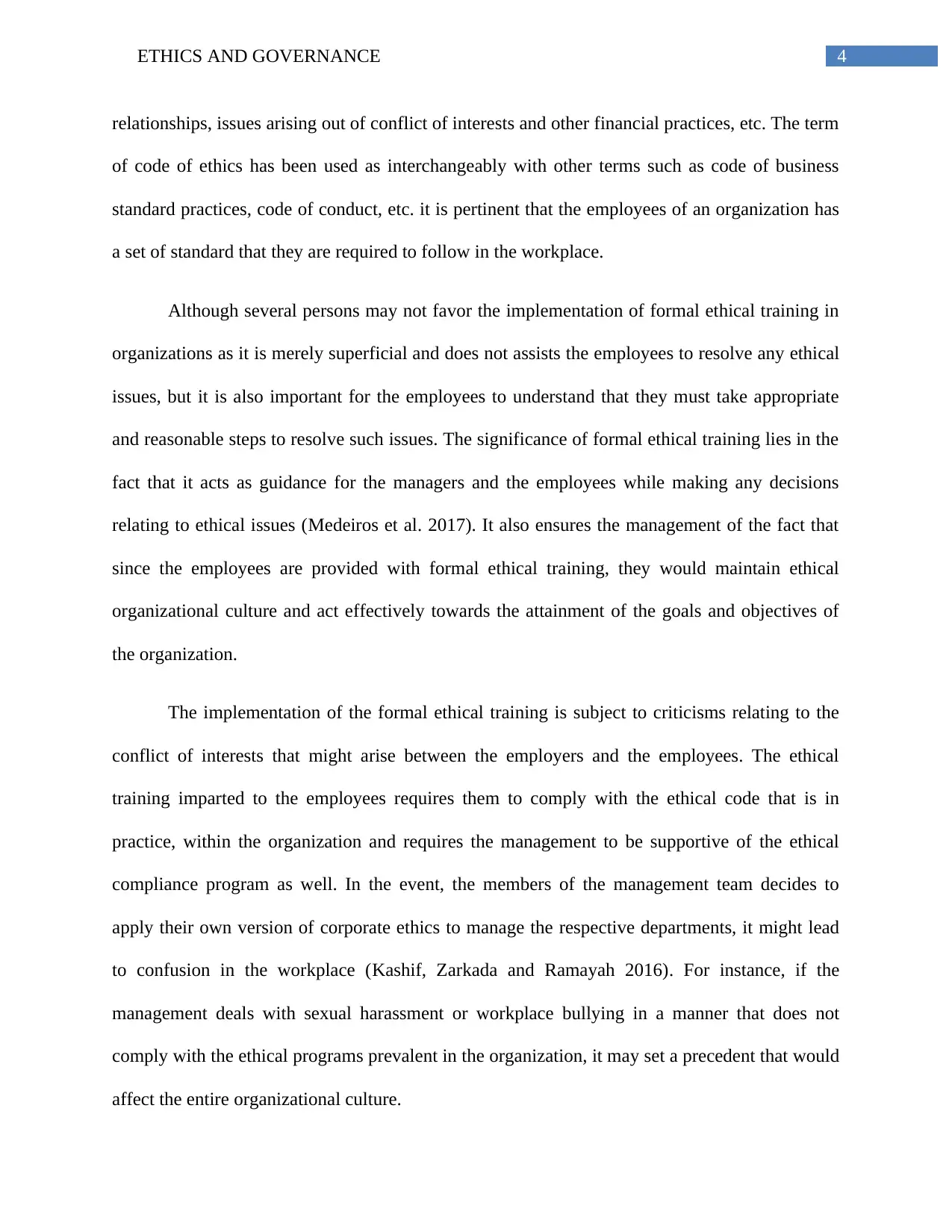
4ETHICS AND GOVERNANCE
relationships, issues arising out of conflict of interests and other financial practices, etc. The term
of code of ethics has been used as interchangeably with other terms such as code of business
standard practices, code of conduct, etc. it is pertinent that the employees of an organization has
a set of standard that they are required to follow in the workplace.
Although several persons may not favor the implementation of formal ethical training in
organizations as it is merely superficial and does not assists the employees to resolve any ethical
issues, but it is also important for the employees to understand that they must take appropriate
and reasonable steps to resolve such issues. The significance of formal ethical training lies in the
fact that it acts as guidance for the managers and the employees while making any decisions
relating to ethical issues (Medeiros et al. 2017). It also ensures the management of the fact that
since the employees are provided with formal ethical training, they would maintain ethical
organizational culture and act effectively towards the attainment of the goals and objectives of
the organization.
The implementation of the formal ethical training is subject to criticisms relating to the
conflict of interests that might arise between the employers and the employees. The ethical
training imparted to the employees requires them to comply with the ethical code that is in
practice, within the organization and requires the management to be supportive of the ethical
compliance program as well. In the event, the members of the management team decides to
apply their own version of corporate ethics to manage the respective departments, it might lead
to confusion in the workplace (Kashif, Zarkada and Ramayah 2016). For instance, if the
management deals with sexual harassment or workplace bullying in a manner that does not
comply with the ethical programs prevalent in the organization, it may set a precedent that would
affect the entire organizational culture.
relationships, issues arising out of conflict of interests and other financial practices, etc. The term
of code of ethics has been used as interchangeably with other terms such as code of business
standard practices, code of conduct, etc. it is pertinent that the employees of an organization has
a set of standard that they are required to follow in the workplace.
Although several persons may not favor the implementation of formal ethical training in
organizations as it is merely superficial and does not assists the employees to resolve any ethical
issues, but it is also important for the employees to understand that they must take appropriate
and reasonable steps to resolve such issues. The significance of formal ethical training lies in the
fact that it acts as guidance for the managers and the employees while making any decisions
relating to ethical issues (Medeiros et al. 2017). It also ensures the management of the fact that
since the employees are provided with formal ethical training, they would maintain ethical
organizational culture and act effectively towards the attainment of the goals and objectives of
the organization.
The implementation of the formal ethical training is subject to criticisms relating to the
conflict of interests that might arise between the employers and the employees. The ethical
training imparted to the employees requires them to comply with the ethical code that is in
practice, within the organization and requires the management to be supportive of the ethical
compliance program as well. In the event, the members of the management team decides to
apply their own version of corporate ethics to manage the respective departments, it might lead
to confusion in the workplace (Kashif, Zarkada and Ramayah 2016). For instance, if the
management deals with sexual harassment or workplace bullying in a manner that does not
comply with the ethical programs prevalent in the organization, it may set a precedent that would
affect the entire organizational culture.
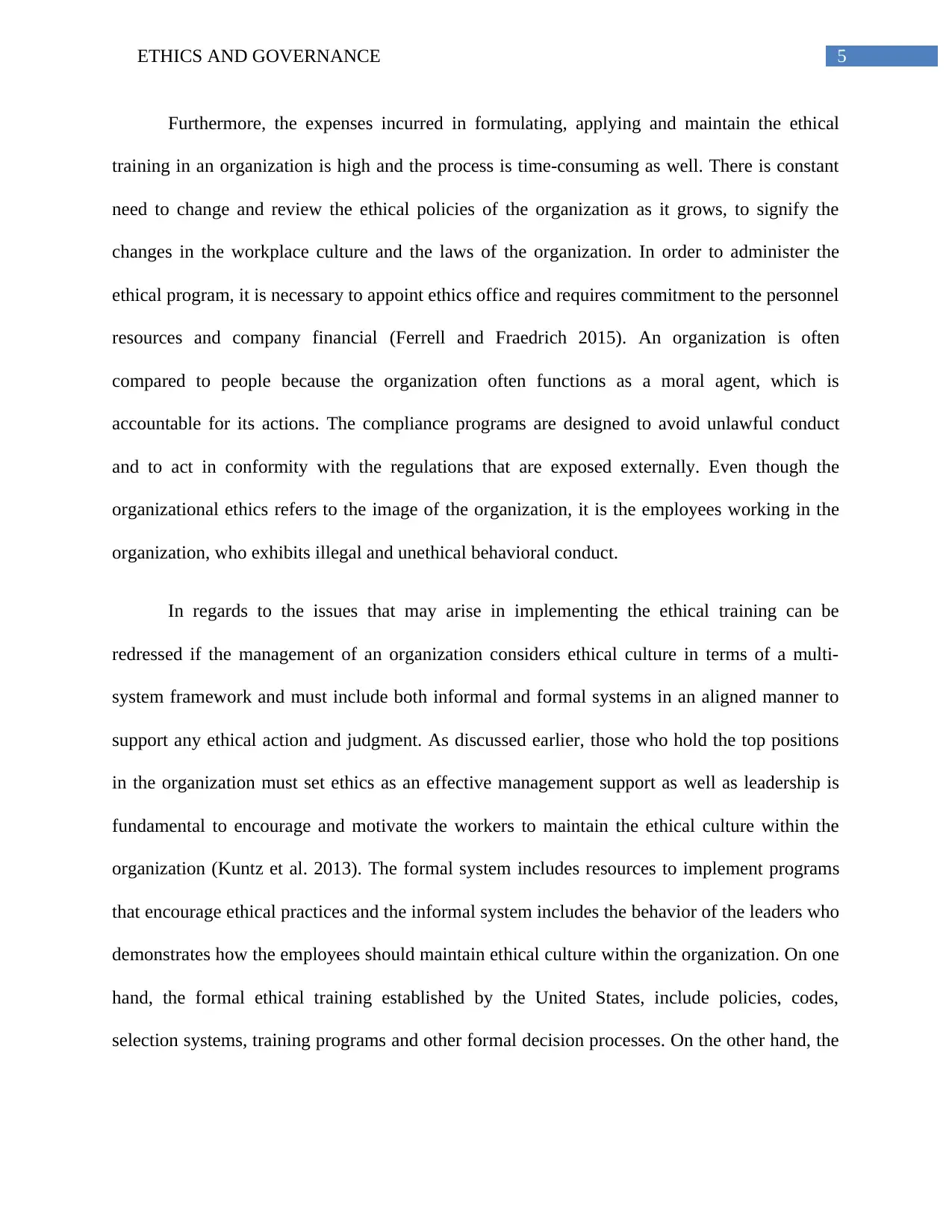
5ETHICS AND GOVERNANCE
Furthermore, the expenses incurred in formulating, applying and maintain the ethical
training in an organization is high and the process is time-consuming as well. There is constant
need to change and review the ethical policies of the organization as it grows, to signify the
changes in the workplace culture and the laws of the organization. In order to administer the
ethical program, it is necessary to appoint ethics office and requires commitment to the personnel
resources and company financial (Ferrell and Fraedrich 2015). An organization is often
compared to people because the organization often functions as a moral agent, which is
accountable for its actions. The compliance programs are designed to avoid unlawful conduct
and to act in conformity with the regulations that are exposed externally. Even though the
organizational ethics refers to the image of the organization, it is the employees working in the
organization, who exhibits illegal and unethical behavioral conduct.
In regards to the issues that may arise in implementing the ethical training can be
redressed if the management of an organization considers ethical culture in terms of a multi-
system framework and must include both informal and formal systems in an aligned manner to
support any ethical action and judgment. As discussed earlier, those who hold the top positions
in the organization must set ethics as an effective management support as well as leadership is
fundamental to encourage and motivate the workers to maintain the ethical culture within the
organization (Kuntz et al. 2013). The formal system includes resources to implement programs
that encourage ethical practices and the informal system includes the behavior of the leaders who
demonstrates how the employees should maintain ethical culture within the organization. On one
hand, the formal ethical training established by the United States, include policies, codes,
selection systems, training programs and other formal decision processes. On the other hand, the
Furthermore, the expenses incurred in formulating, applying and maintain the ethical
training in an organization is high and the process is time-consuming as well. There is constant
need to change and review the ethical policies of the organization as it grows, to signify the
changes in the workplace culture and the laws of the organization. In order to administer the
ethical program, it is necessary to appoint ethics office and requires commitment to the personnel
resources and company financial (Ferrell and Fraedrich 2015). An organization is often
compared to people because the organization often functions as a moral agent, which is
accountable for its actions. The compliance programs are designed to avoid unlawful conduct
and to act in conformity with the regulations that are exposed externally. Even though the
organizational ethics refers to the image of the organization, it is the employees working in the
organization, who exhibits illegal and unethical behavioral conduct.
In regards to the issues that may arise in implementing the ethical training can be
redressed if the management of an organization considers ethical culture in terms of a multi-
system framework and must include both informal and formal systems in an aligned manner to
support any ethical action and judgment. As discussed earlier, those who hold the top positions
in the organization must set ethics as an effective management support as well as leadership is
fundamental to encourage and motivate the workers to maintain the ethical culture within the
organization (Kuntz et al. 2013). The formal system includes resources to implement programs
that encourage ethical practices and the informal system includes the behavior of the leaders who
demonstrates how the employees should maintain ethical culture within the organization. On one
hand, the formal ethical training established by the United States, include policies, codes,
selection systems, training programs and other formal decision processes. On the other hand, the
⊘ This is a preview!⊘
Do you want full access?
Subscribe today to unlock all pages.

Trusted by 1+ million students worldwide
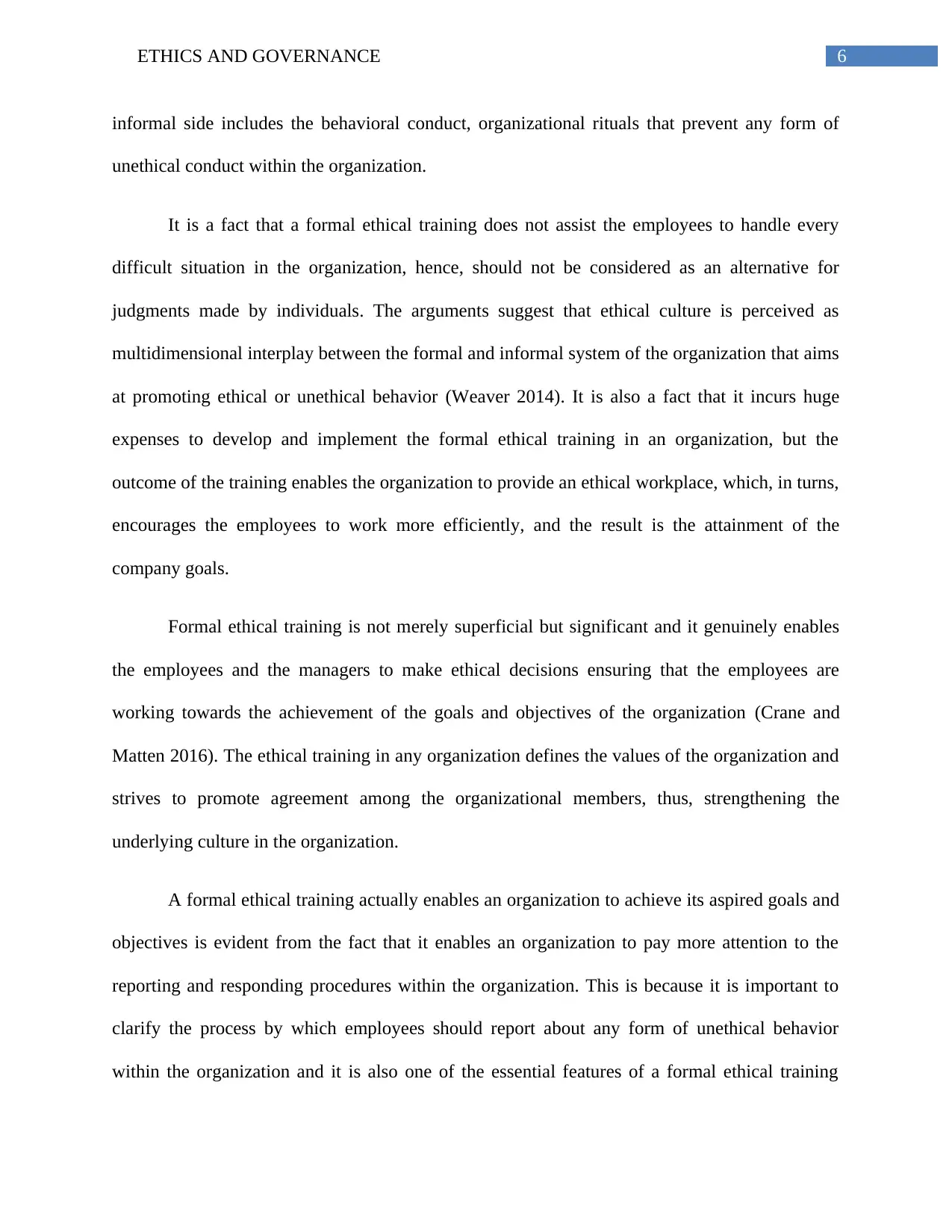
6ETHICS AND GOVERNANCE
informal side includes the behavioral conduct, organizational rituals that prevent any form of
unethical conduct within the organization.
It is a fact that a formal ethical training does not assist the employees to handle every
difficult situation in the organization, hence, should not be considered as an alternative for
judgments made by individuals. The arguments suggest that ethical culture is perceived as
multidimensional interplay between the formal and informal system of the organization that aims
at promoting ethical or unethical behavior (Weaver 2014). It is also a fact that it incurs huge
expenses to develop and implement the formal ethical training in an organization, but the
outcome of the training enables the organization to provide an ethical workplace, which, in turns,
encourages the employees to work more efficiently, and the result is the attainment of the
company goals.
Formal ethical training is not merely superficial but significant and it genuinely enables
the employees and the managers to make ethical decisions ensuring that the employees are
working towards the achievement of the goals and objectives of the organization (Crane and
Matten 2016). The ethical training in any organization defines the values of the organization and
strives to promote agreement among the organizational members, thus, strengthening the
underlying culture in the organization.
A formal ethical training actually enables an organization to achieve its aspired goals and
objectives is evident from the fact that it enables an organization to pay more attention to the
reporting and responding procedures within the organization. This is because it is important to
clarify the process by which employees should report about any form of unethical behavior
within the organization and it is also one of the essential features of a formal ethical training
informal side includes the behavioral conduct, organizational rituals that prevent any form of
unethical conduct within the organization.
It is a fact that a formal ethical training does not assist the employees to handle every
difficult situation in the organization, hence, should not be considered as an alternative for
judgments made by individuals. The arguments suggest that ethical culture is perceived as
multidimensional interplay between the formal and informal system of the organization that aims
at promoting ethical or unethical behavior (Weaver 2014). It is also a fact that it incurs huge
expenses to develop and implement the formal ethical training in an organization, but the
outcome of the training enables the organization to provide an ethical workplace, which, in turns,
encourages the employees to work more efficiently, and the result is the attainment of the
company goals.
Formal ethical training is not merely superficial but significant and it genuinely enables
the employees and the managers to make ethical decisions ensuring that the employees are
working towards the achievement of the goals and objectives of the organization (Crane and
Matten 2016). The ethical training in any organization defines the values of the organization and
strives to promote agreement among the organizational members, thus, strengthening the
underlying culture in the organization.
A formal ethical training actually enables an organization to achieve its aspired goals and
objectives is evident from the fact that it enables an organization to pay more attention to the
reporting and responding procedures within the organization. This is because it is important to
clarify the process by which employees should report about any form of unethical behavior
within the organization and it is also one of the essential features of a formal ethical training
Paraphrase This Document
Need a fresh take? Get an instant paraphrase of this document with our AI Paraphraser
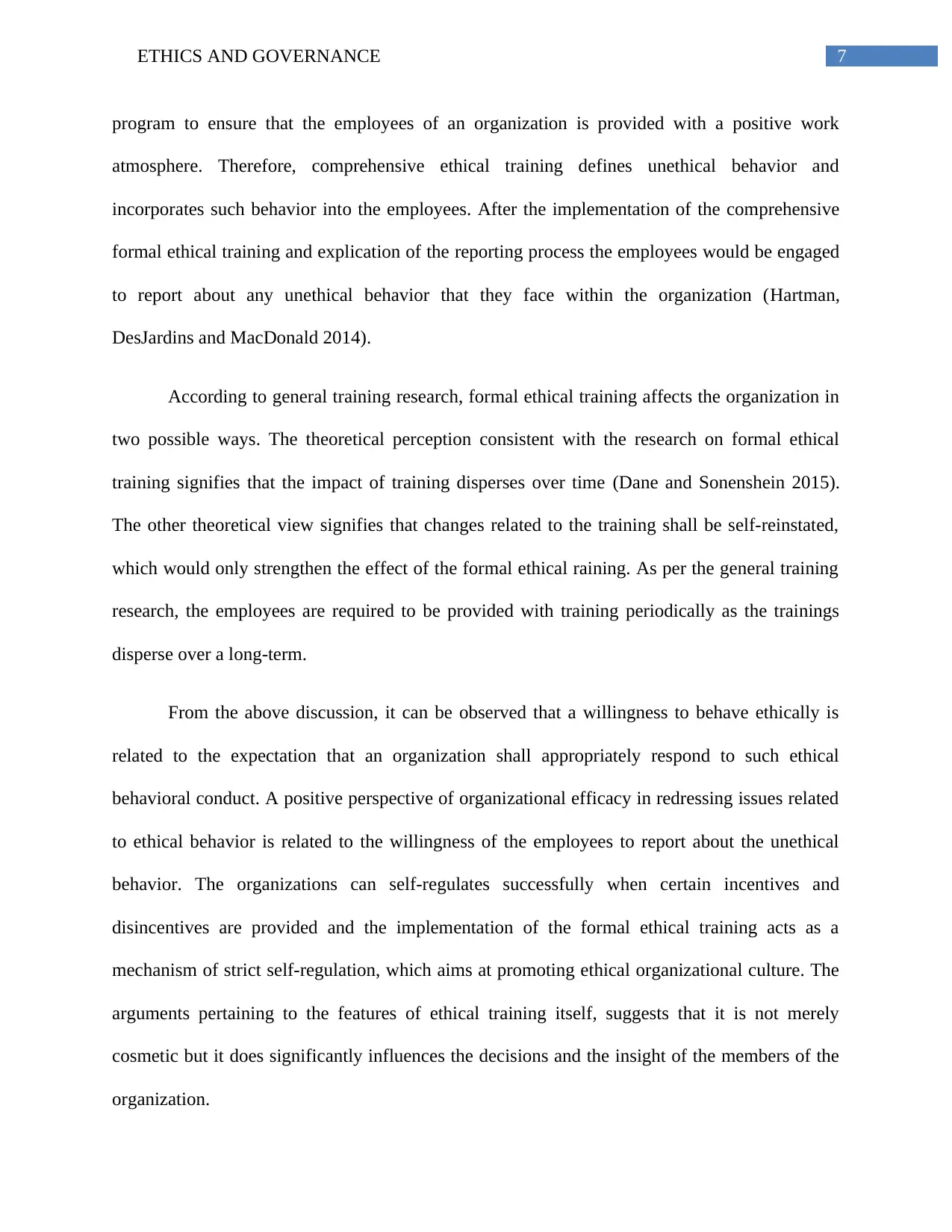
7ETHICS AND GOVERNANCE
program to ensure that the employees of an organization is provided with a positive work
atmosphere. Therefore, comprehensive ethical training defines unethical behavior and
incorporates such behavior into the employees. After the implementation of the comprehensive
formal ethical training and explication of the reporting process the employees would be engaged
to report about any unethical behavior that they face within the organization (Hartman,
DesJardins and MacDonald 2014).
According to general training research, formal ethical training affects the organization in
two possible ways. The theoretical perception consistent with the research on formal ethical
training signifies that the impact of training disperses over time (Dane and Sonenshein 2015).
The other theoretical view signifies that changes related to the training shall be self-reinstated,
which would only strengthen the effect of the formal ethical raining. As per the general training
research, the employees are required to be provided with training periodically as the trainings
disperse over a long-term.
From the above discussion, it can be observed that a willingness to behave ethically is
related to the expectation that an organization shall appropriately respond to such ethical
behavioral conduct. A positive perspective of organizational efficacy in redressing issues related
to ethical behavior is related to the willingness of the employees to report about the unethical
behavior. The organizations can self-regulates successfully when certain incentives and
disincentives are provided and the implementation of the formal ethical training acts as a
mechanism of strict self-regulation, which aims at promoting ethical organizational culture. The
arguments pertaining to the features of ethical training itself, suggests that it is not merely
cosmetic but it does significantly influences the decisions and the insight of the members of the
organization.
program to ensure that the employees of an organization is provided with a positive work
atmosphere. Therefore, comprehensive ethical training defines unethical behavior and
incorporates such behavior into the employees. After the implementation of the comprehensive
formal ethical training and explication of the reporting process the employees would be engaged
to report about any unethical behavior that they face within the organization (Hartman,
DesJardins and MacDonald 2014).
According to general training research, formal ethical training affects the organization in
two possible ways. The theoretical perception consistent with the research on formal ethical
training signifies that the impact of training disperses over time (Dane and Sonenshein 2015).
The other theoretical view signifies that changes related to the training shall be self-reinstated,
which would only strengthen the effect of the formal ethical raining. As per the general training
research, the employees are required to be provided with training periodically as the trainings
disperse over a long-term.
From the above discussion, it can be observed that a willingness to behave ethically is
related to the expectation that an organization shall appropriately respond to such ethical
behavioral conduct. A positive perspective of organizational efficacy in redressing issues related
to ethical behavior is related to the willingness of the employees to report about the unethical
behavior. The organizations can self-regulates successfully when certain incentives and
disincentives are provided and the implementation of the formal ethical training acts as a
mechanism of strict self-regulation, which aims at promoting ethical organizational culture. The
arguments pertaining to the features of ethical training itself, suggests that it is not merely
cosmetic but it does significantly influences the decisions and the insight of the members of the
organization.
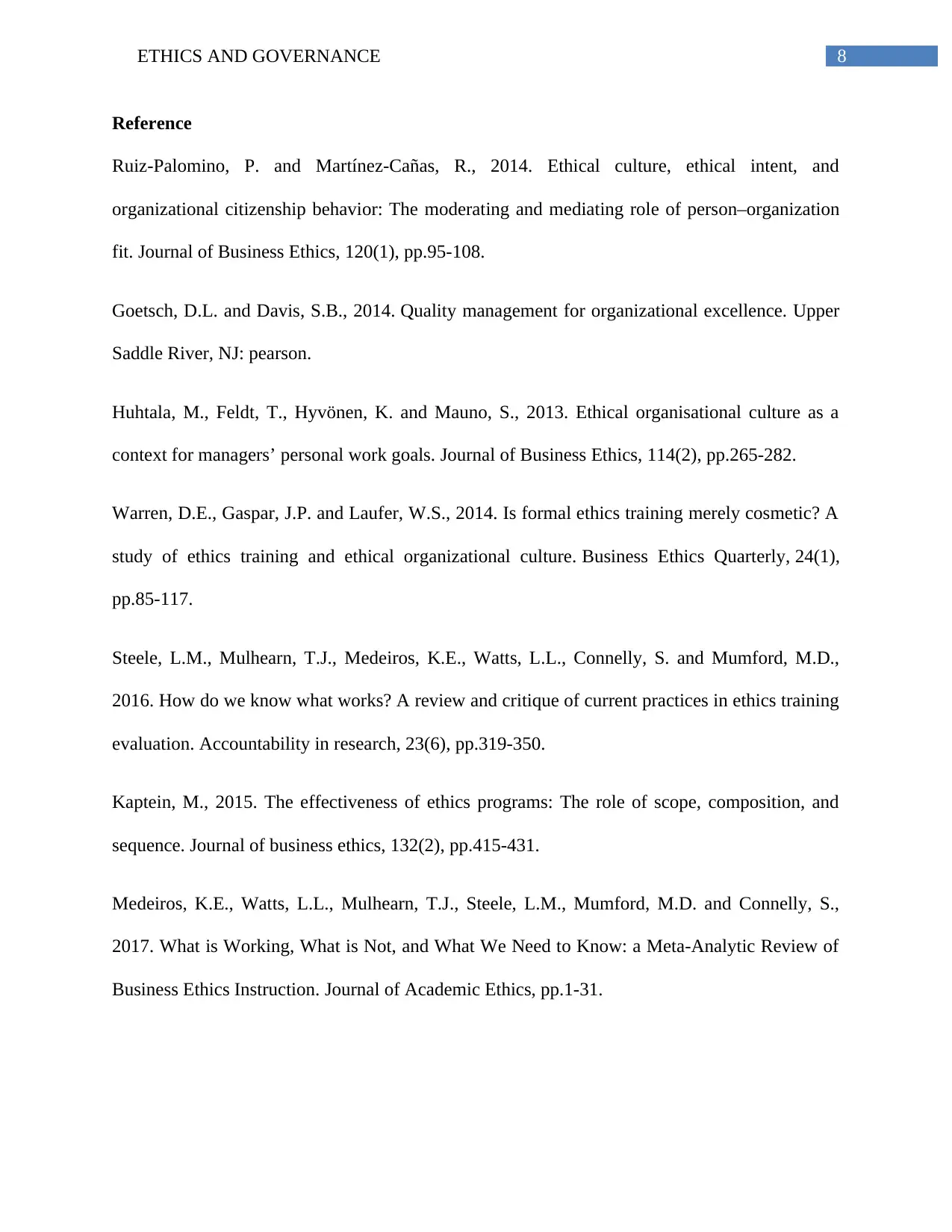
8ETHICS AND GOVERNANCE
Reference
Ruiz-Palomino, P. and Martínez-Cañas, R., 2014. Ethical culture, ethical intent, and
organizational citizenship behavior: The moderating and mediating role of person–organization
fit. Journal of Business Ethics, 120(1), pp.95-108.
Goetsch, D.L. and Davis, S.B., 2014. Quality management for organizational excellence. Upper
Saddle River, NJ: pearson.
Huhtala, M., Feldt, T., Hyvönen, K. and Mauno, S., 2013. Ethical organisational culture as a
context for managers’ personal work goals. Journal of Business Ethics, 114(2), pp.265-282.
Warren, D.E., Gaspar, J.P. and Laufer, W.S., 2014. Is formal ethics training merely cosmetic? A
study of ethics training and ethical organizational culture. Business Ethics Quarterly, 24(1),
pp.85-117.
Steele, L.M., Mulhearn, T.J., Medeiros, K.E., Watts, L.L., Connelly, S. and Mumford, M.D.,
2016. How do we know what works? A review and critique of current practices in ethics training
evaluation. Accountability in research, 23(6), pp.319-350.
Kaptein, M., 2015. The effectiveness of ethics programs: The role of scope, composition, and
sequence. Journal of business ethics, 132(2), pp.415-431.
Medeiros, K.E., Watts, L.L., Mulhearn, T.J., Steele, L.M., Mumford, M.D. and Connelly, S.,
2017. What is Working, What is Not, and What We Need to Know: a Meta-Analytic Review of
Business Ethics Instruction. Journal of Academic Ethics, pp.1-31.
Reference
Ruiz-Palomino, P. and Martínez-Cañas, R., 2014. Ethical culture, ethical intent, and
organizational citizenship behavior: The moderating and mediating role of person–organization
fit. Journal of Business Ethics, 120(1), pp.95-108.
Goetsch, D.L. and Davis, S.B., 2014. Quality management for organizational excellence. Upper
Saddle River, NJ: pearson.
Huhtala, M., Feldt, T., Hyvönen, K. and Mauno, S., 2013. Ethical organisational culture as a
context for managers’ personal work goals. Journal of Business Ethics, 114(2), pp.265-282.
Warren, D.E., Gaspar, J.P. and Laufer, W.S., 2014. Is formal ethics training merely cosmetic? A
study of ethics training and ethical organizational culture. Business Ethics Quarterly, 24(1),
pp.85-117.
Steele, L.M., Mulhearn, T.J., Medeiros, K.E., Watts, L.L., Connelly, S. and Mumford, M.D.,
2016. How do we know what works? A review and critique of current practices in ethics training
evaluation. Accountability in research, 23(6), pp.319-350.
Kaptein, M., 2015. The effectiveness of ethics programs: The role of scope, composition, and
sequence. Journal of business ethics, 132(2), pp.415-431.
Medeiros, K.E., Watts, L.L., Mulhearn, T.J., Steele, L.M., Mumford, M.D. and Connelly, S.,
2017. What is Working, What is Not, and What We Need to Know: a Meta-Analytic Review of
Business Ethics Instruction. Journal of Academic Ethics, pp.1-31.
⊘ This is a preview!⊘
Do you want full access?
Subscribe today to unlock all pages.

Trusted by 1+ million students worldwide
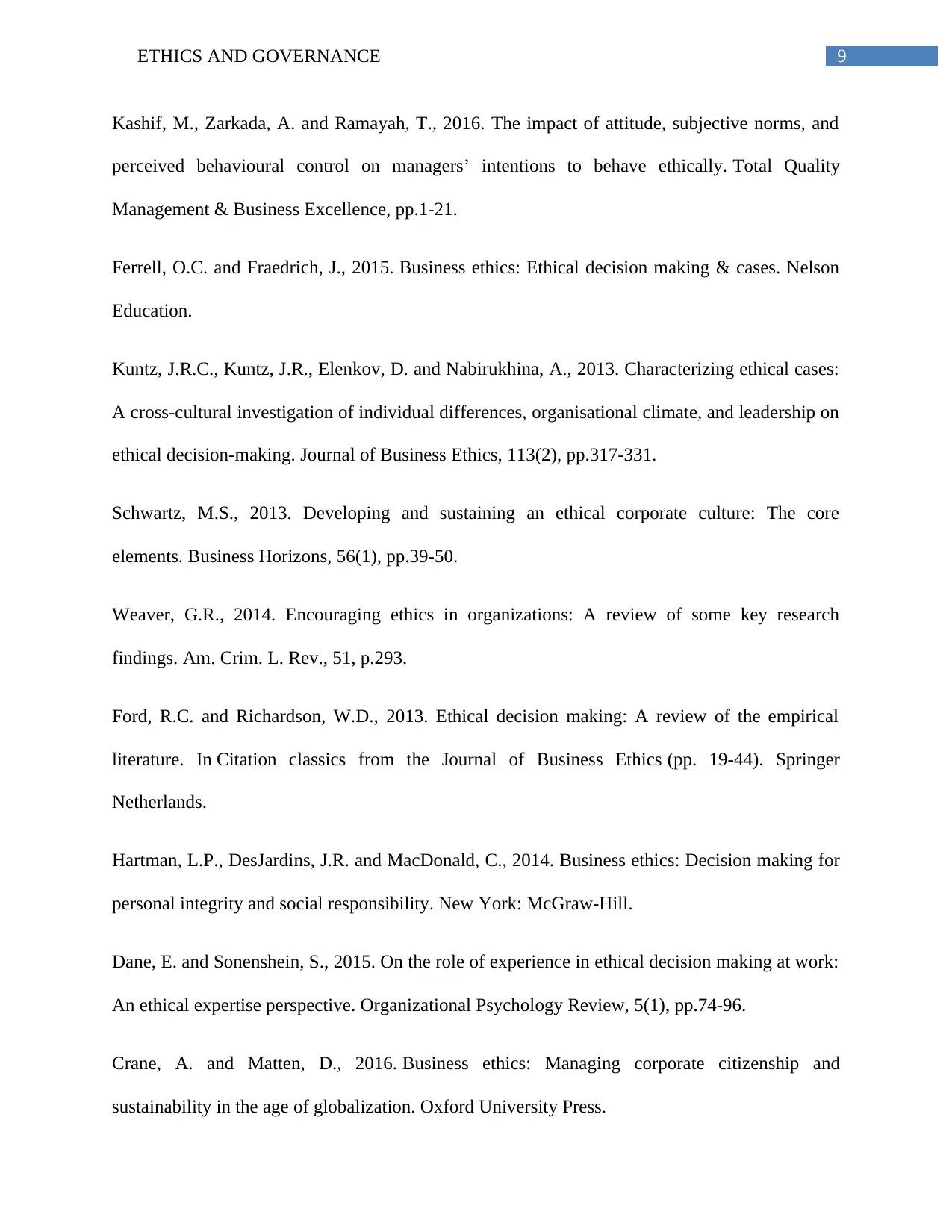
9ETHICS AND GOVERNANCE
Kashif, M., Zarkada, A. and Ramayah, T., 2016. The impact of attitude, subjective norms, and
perceived behavioural control on managers’ intentions to behave ethically. Total Quality
Management & Business Excellence, pp.1-21.
Ferrell, O.C. and Fraedrich, J., 2015. Business ethics: Ethical decision making & cases. Nelson
Education.
Kuntz, J.R.C., Kuntz, J.R., Elenkov, D. and Nabirukhina, A., 2013. Characterizing ethical cases:
A cross-cultural investigation of individual differences, organisational climate, and leadership on
ethical decision-making. Journal of Business Ethics, 113(2), pp.317-331.
Schwartz, M.S., 2013. Developing and sustaining an ethical corporate culture: The core
elements. Business Horizons, 56(1), pp.39-50.
Weaver, G.R., 2014. Encouraging ethics in organizations: A review of some key research
findings. Am. Crim. L. Rev., 51, p.293.
Ford, R.C. and Richardson, W.D., 2013. Ethical decision making: A review of the empirical
literature. In Citation classics from the Journal of Business Ethics (pp. 19-44). Springer
Netherlands.
Hartman, L.P., DesJardins, J.R. and MacDonald, C., 2014. Business ethics: Decision making for
personal integrity and social responsibility. New York: McGraw-Hill.
Dane, E. and Sonenshein, S., 2015. On the role of experience in ethical decision making at work:
An ethical expertise perspective. Organizational Psychology Review, 5(1), pp.74-96.
Crane, A. and Matten, D., 2016. Business ethics: Managing corporate citizenship and
sustainability in the age of globalization. Oxford University Press.
Kashif, M., Zarkada, A. and Ramayah, T., 2016. The impact of attitude, subjective norms, and
perceived behavioural control on managers’ intentions to behave ethically. Total Quality
Management & Business Excellence, pp.1-21.
Ferrell, O.C. and Fraedrich, J., 2015. Business ethics: Ethical decision making & cases. Nelson
Education.
Kuntz, J.R.C., Kuntz, J.R., Elenkov, D. and Nabirukhina, A., 2013. Characterizing ethical cases:
A cross-cultural investigation of individual differences, organisational climate, and leadership on
ethical decision-making. Journal of Business Ethics, 113(2), pp.317-331.
Schwartz, M.S., 2013. Developing and sustaining an ethical corporate culture: The core
elements. Business Horizons, 56(1), pp.39-50.
Weaver, G.R., 2014. Encouraging ethics in organizations: A review of some key research
findings. Am. Crim. L. Rev., 51, p.293.
Ford, R.C. and Richardson, W.D., 2013. Ethical decision making: A review of the empirical
literature. In Citation classics from the Journal of Business Ethics (pp. 19-44). Springer
Netherlands.
Hartman, L.P., DesJardins, J.R. and MacDonald, C., 2014. Business ethics: Decision making for
personal integrity and social responsibility. New York: McGraw-Hill.
Dane, E. and Sonenshein, S., 2015. On the role of experience in ethical decision making at work:
An ethical expertise perspective. Organizational Psychology Review, 5(1), pp.74-96.
Crane, A. and Matten, D., 2016. Business ethics: Managing corporate citizenship and
sustainability in the age of globalization. Oxford University Press.
1 out of 10
Related Documents
Your All-in-One AI-Powered Toolkit for Academic Success.
+13062052269
info@desklib.com
Available 24*7 on WhatsApp / Email
![[object Object]](/_next/static/media/star-bottom.7253800d.svg)
Unlock your academic potential
Copyright © 2020–2025 A2Z Services. All Rights Reserved. Developed and managed by ZUCOL.


![Corporate Governance and Ethics Report: [University Name]](/_next/image/?url=https%3A%2F%2Fdesklib.com%2Fmedia%2Fimages%2Fxn%2F3c55d29f50c44e168436c76554bbf9af.jpg&w=256&q=75)


